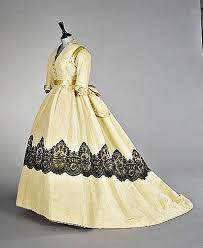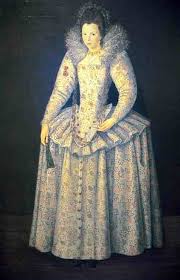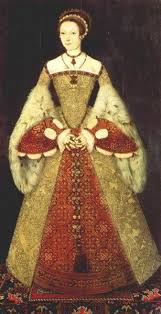Hello again! By this time, you've probably chosen the time frame you wish to reenact or a historical style that appeals to you. Great! Let's move on.
Styles change, sometimes slowly (as in the Middle Ages), sometimes at supersonic speed (as happened in the late Twentieth Century). Sometimes the entire silhouette of a fashion changed. Other times, only the details changed.
The first detail is overall shape (the silhouette). This can range anywhere from straight up and down (e.g., caftans, Regency round gowns, 1920's flapper styles, 1960's mod) to highly shaped and formed (Tudor period, most of the mid-to-late 1800s). Some of these silhouettes are more suited to our shape than others, so we need to be honest with ourselves if we are choosing a time frame based on personal inclinations rather than a group effort.
The second largest detail is materials: fabric, leathers, furs, feathers (don't panic if you are anti-fur! Some modern synthetics will give you just as good a representation as the real thing), lace, and other trimmings.
These two things taken together can greatly affect the appeal of a garment, and slight changes can make a big difference!
If you are making your own costume, you can choose as you like. My one recommendation is that if you want a style from before the invention of rayon (known at the time as artificial silk, manufactured in the USA by the American Viscose Company in 1910), do your best to use natural fibers. Each historical period had preferred fabrics, and each strata of society had access to differing levels of quality, so that should also affect your decision.
Believe it or not, the cost of manufacturing homespun these days has driven the prices much higher than equivalent natural fabrics woven in mills. For those of you who remember "Little House on the Prairie," the cost of those "homespun" dresses Mrs. Ingalls wore was astronomical, due to the unavailability of "real" homespun, necessitating the use of coarsely woven silk! (Or so I've heard.)
So, if you choose to portray a peasant, be aware that your costume may cost more than a nobleman or -woman's garb!
That's it for today. More on fabrics next time. Any questions about costuming? Please feel free to ask!
Tuesday, 15 January 2013
Tuesday, 8 January 2013
Finding Your Costume Style
If you're in a group of historical reenactors, you probably have already found your costume style. The group will set the time frame into which your costume must fit, give or take a few years (or possibly decades). One important thing to remember if you're going to take liberties with the time frame in a historical context: always go back in time from the time frame, not forward. Your historical character might like to wear garments from an earlier generation, but they certainly can't wear something that hasn't been invented yet!
 Here's an example. Say your group reenacts the Civil War, circa 1864. By that time, the crinoline and hoops had begun to gravitate away from the circular mode of the previous decade, toward the back of the dress. While those who could afford it probably adopted the new design immediately, those of lesser means or whose information about fashion was limited to what could be smuggled through enemy lines still wore the round crinolines. Shoulders were still sloping and the sleeve beginning on the upper arm rather than the shoulder line, but the fashion was changing ever so slightly.
Here's an example. Say your group reenacts the Civil War, circa 1864. By that time, the crinoline and hoops had begun to gravitate away from the circular mode of the previous decade, toward the back of the dress. While those who could afford it probably adopted the new design immediately, those of lesser means or whose information about fashion was limited to what could be smuggled through enemy lines still wore the round crinolines. Shoulders were still sloping and the sleeve beginning on the upper arm rather than the shoulder line, but the fashion was changing ever so slightly.

 Another example: During the Tudor period, the earliest wide skirt used the Spanish farthingale, which belled out much like the later hoop skirts of the 1860s, though in a straighter line from waist to floor. Successive fashion mania went through wide farthingales and even into the wheel. However, only those at Court followed fashion religiously. Changes in style took their time making their way down through the echelons of society.
Another example: During the Tudor period, the earliest wide skirt used the Spanish farthingale, which belled out much like the later hoop skirts of the 1860s, though in a straighter line from waist to floor. Successive fashion mania went through wide farthingales and even into the wheel. However, only those at Court followed fashion religiously. Changes in style took their time making their way down through the echelons of society.
"But I'm not in a group!" you say. "I just want to do something I'll like."
Great! Time is your oyster, to paraphrase a thought. You have all of history at your disposal. Look through books on costume history, browse images on the web, find what you like. If you simply want to add a few period touches to your everyday clothes, you can!
You can choose designs that will make the most of your shape, no matter what it is. If you're especially slender, early Regency dress may appeal to you. Muscular man? Try adding a little Norse to your outfit, or some Wild West. Not enough to look costume-y, but enough to give you the satisfaction that you look different from the rest of the herd without looking ridiculous.
In the end, only you can decide your costume style. You may find more than one historical period appeals to you. If that's the case, you can mix it up as you please. I love lots of different historical periods and styles.
Which one is your favorite? I hope you'll share it with us here!
"But I'm not in a group!" you say. "I just want to do something I'll like."
Great! Time is your oyster, to paraphrase a thought. You have all of history at your disposal. Look through books on costume history, browse images on the web, find what you like. If you simply want to add a few period touches to your everyday clothes, you can!
You can choose designs that will make the most of your shape, no matter what it is. If you're especially slender, early Regency dress may appeal to you. Muscular man? Try adding a little Norse to your outfit, or some Wild West. Not enough to look costume-y, but enough to give you the satisfaction that you look different from the rest of the herd without looking ridiculous.
In the end, only you can decide your costume style. You may find more than one historical period appeals to you. If that's the case, you can mix it up as you please. I love lots of different historical periods and styles.
Which one is your favorite? I hope you'll share it with us here!
Subscribe to:
Comments (Atom)